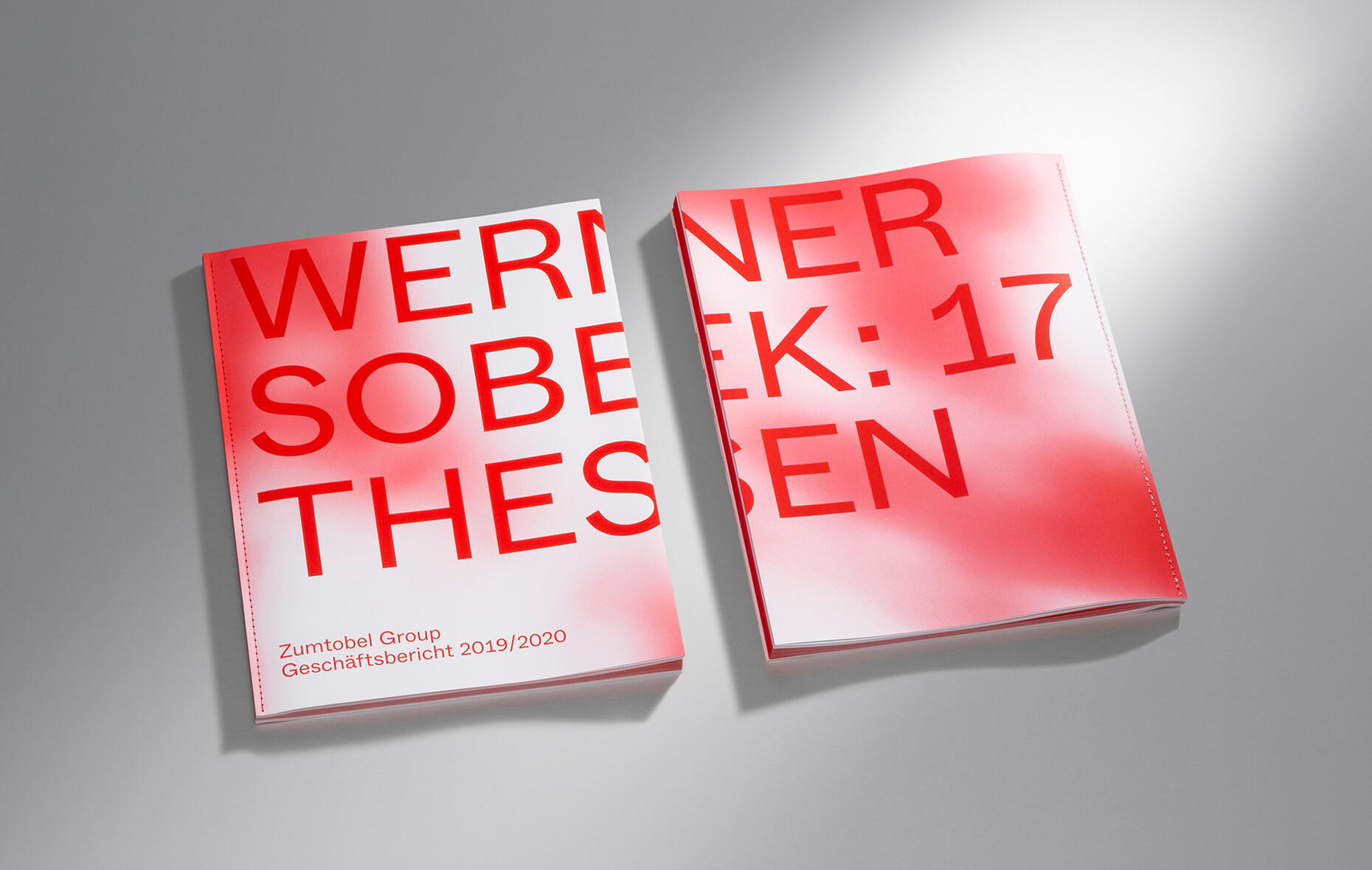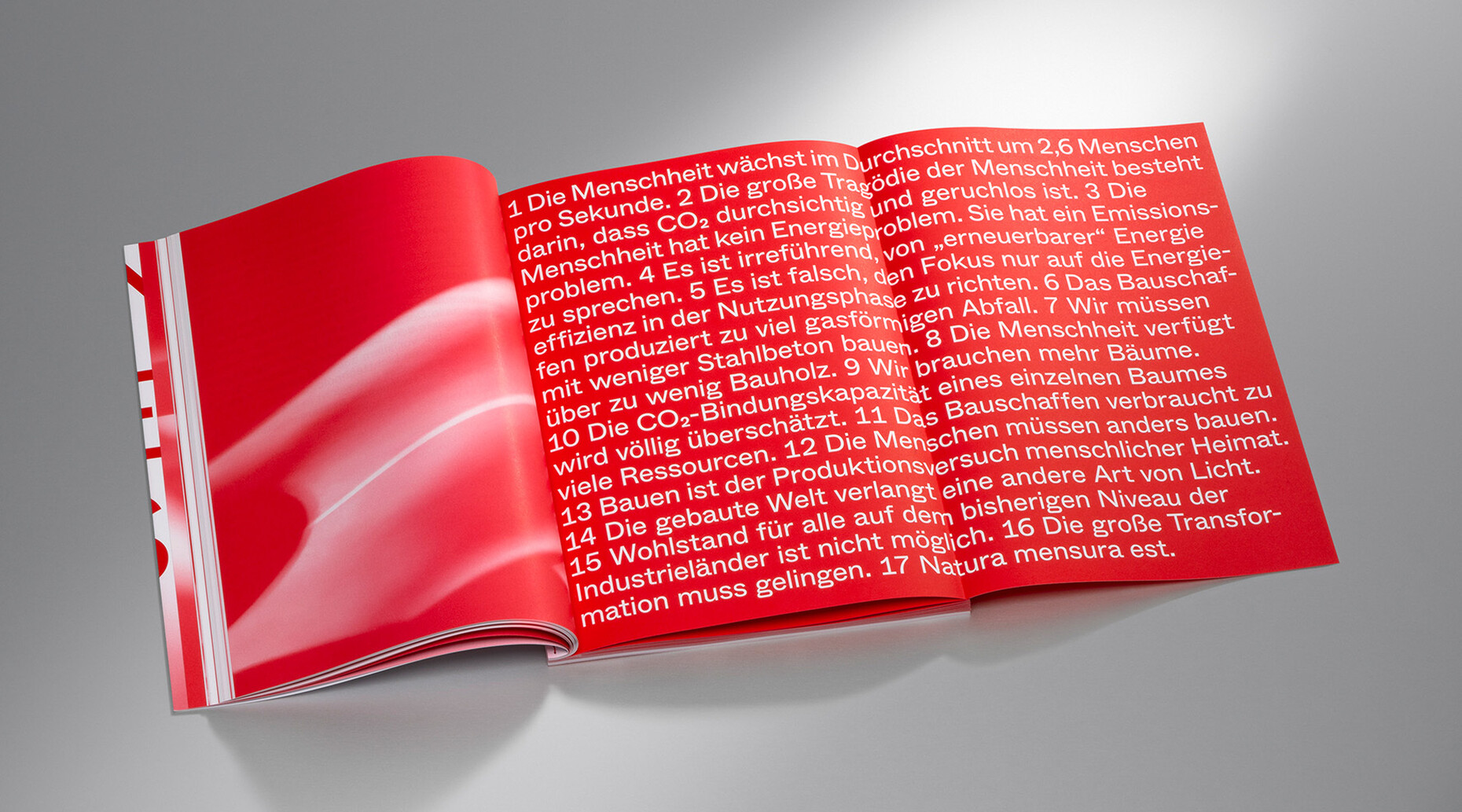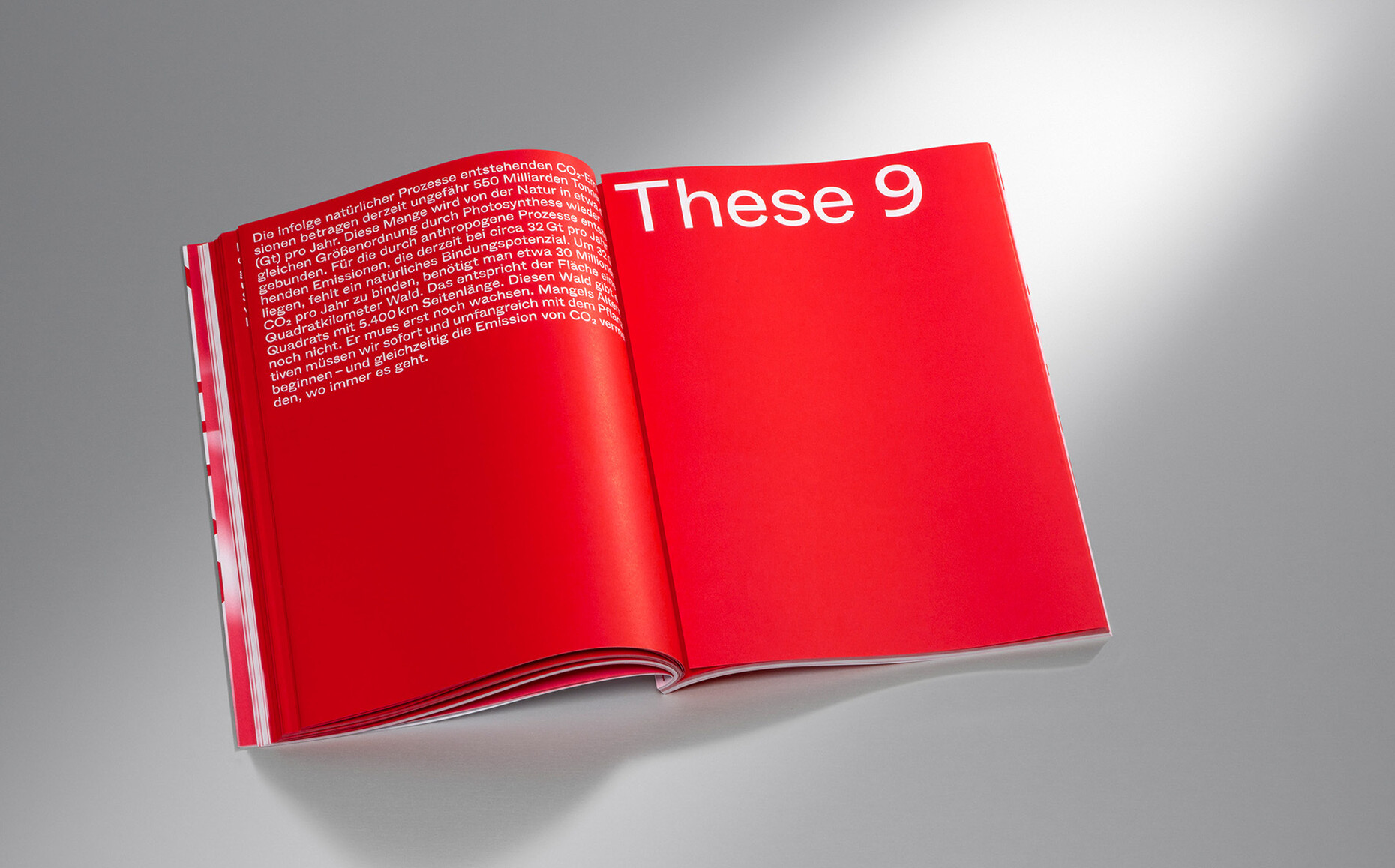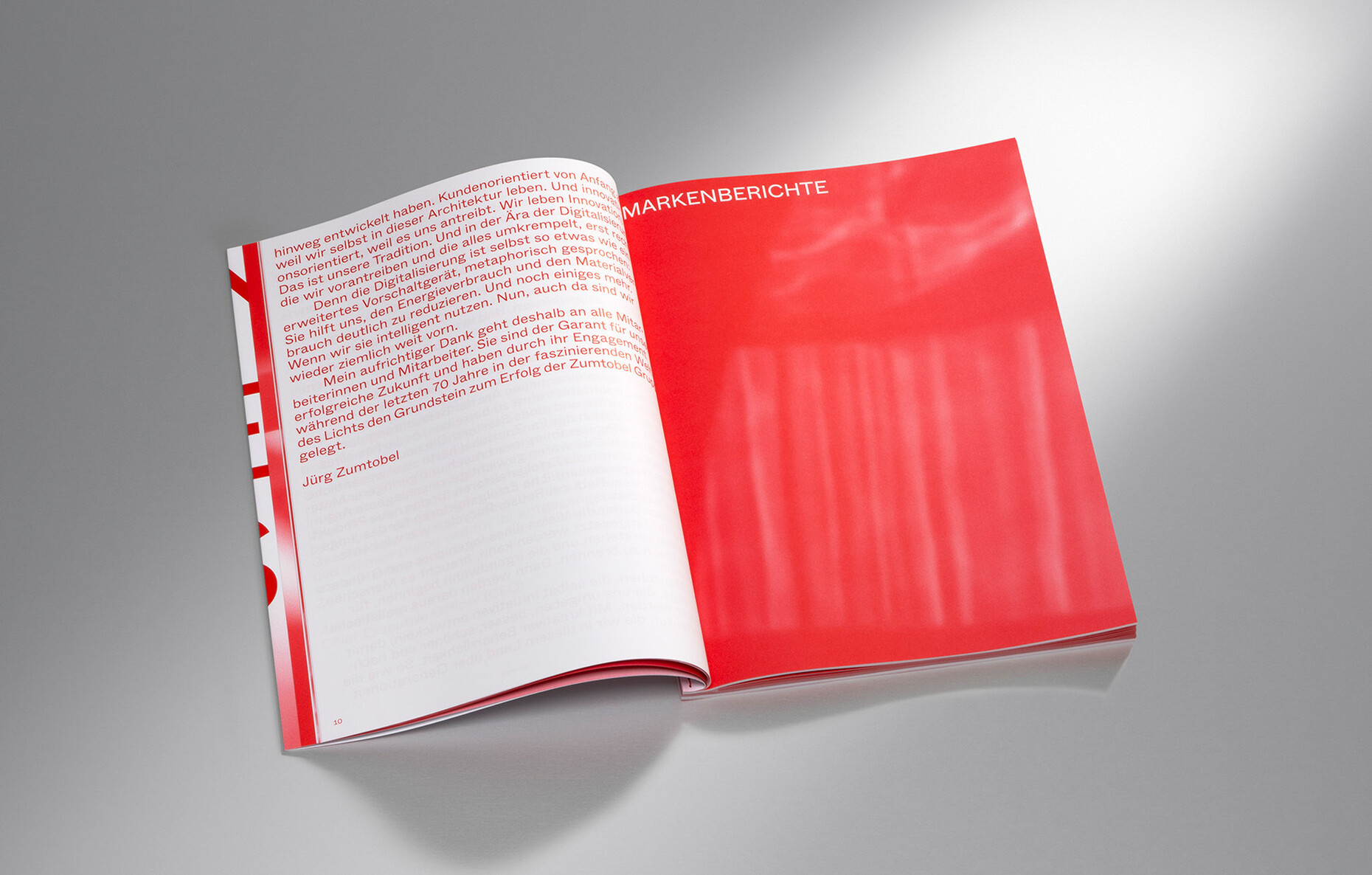Sustainability
Building with future
The Zumtobel Group's Annual Report 2019/2020 shines red: a signal colour designed to draw attention to the urgency of its designer's message. Prof. Werner Sobek created the 29th edition of the annual report together with büro uebele, and focuses on the themes of sustainability and responsibility for the future. The pioneer of sustainability in the construction industry formulated 17 theses that are intended to provide a critical and constructive outlook into the future:
1. The world’s population is growing at an average rate of 2.6 people per second.
This is doubtless the most important figure of all. To meet the associated explosion in demand for buildings and infrastructure in line with Austrian, Swiss or German standards, every year we would need to extract some 40 billion tonnes of construction materials from the earth. This equates to building a wall 1,300 metres high and 30 centimeter thick along the roughly 40,000-kilometre equator of the earth. Every year. Moving forward, we must use less material to build for more people.
2. The fact that CO2 is transparent and odourless is the greatest tragedy for humankind.
The sun alone radiates 10,000 times more energy onto the earth than humankind needs to fulfil all its functions. So we do not have an energy problem. What we do have is an emissions problem caused primarily by climate-damaging gases from the combustion of fossil fuels, biogas and wood. We need policies that address emissions rather than energy. The generation of greenhouse gases must be banned from the production, operation and demolition of our built environment.
3. As human beings, we do not have a problem with energy. We have a problem with emissions.
Energy cannot be created or destroyed. It can only be converted from one form to another. We must use a precise terminology to accurately describe the facts and correlations. This is the foundation on which all insights and scientific knowledge, and indeed democracy itself, are built.
4. It is misleading to speak of "renewable energy".
Calls for energy efficiency during a building’s utilisation phase are actually aimed at reducing the associated emissions. However, the ultimate objective is zero emissions, and this should be clearly stated. In fact, operating the building is only part of the problem. When we look at the buildings currently under construction, around 50 percent of their emissions over the next 60 years will occur before they are even occupied. For infrastructure buildings, that figure is close to 100 percent. These “embodied emissions” generated during the extraction of materials, the production of components and the construction process itself have an immediate and full adverse effect on the environment. In the first 30 years of a building’s lifespan, these embodied emissions will inflict more than eight times as much damage as the emissions arising from its operation during that period. Global construction must shift the focus of its efforts and prioritize a dramatic reduction in embodied emissions.
5. It is wrong to focus only on energy efficiency during the utilisation phase.
The construction and operation of buildings generate around 35–40 percent of all greenhouse gas emissions worldwide. This equates to some 12 billion tonnes of CO2 every year, or 380 tonnes of CO2 per second. Cement production alone emits more CO2 than all global aviation. We must do all we can to minimize, avoid and compensate for emissions associated with the construction, operation and demolition of our built environment.
6. Construction generates excessive waste gases.
Every cubic metre of reinforced concrete leads to emissions of some 330 Kilogramms of CO2. It takes a single large, healthy tree around ten years to sequester this amount of CO2. Reinforced concrete must be used far more sparingly in future, and only in situations where its excellent properties are genuinely needed.
7. We must reduce our use of reinforced concrete.
Hopes of a built environment made almost entirely from wood ignore the fact that there is not enough timber available. If all the earth’s forests were to be managed according to the latest sustainability principles, the potential harvest would be around 12 to 15 billion tonnes of timber per year. Yet the quantity of timber required for construction is several times that amount. Added to this, wood is a chemical feedstock and is also used in the production of furniture, packaging and paper. Last, but not least: the world’s poorest people still rely on wood for heating and cooking. If significantly larger quantities of timber were to be used for construction, this could spark global conflict over natural resource allocation. We need large-scale planting of fast-growing timber suitable for construction. Even though the trees cannot be harvested for several decades, this would represent an important investment in the future. What is more, sequestration of carbon would begin straight away. So forestation is the order of the day.
8. There’s not enough timber in the world.
Natural processes currently emit around 550 billion tonnes (Gt) of CO2 per annum, which are sequestered by nature in roughly equal amounts by means of photosynthesis. There is no natural sequestration potential for the 32 Gt per annum of man-made emissions. It would take around 30 million square kilometres of forest (an area 5,400 kilometres by 5,400 kilometres) to sequester 32 Gt of CO2 per annum. This forest does not yet exist. It needs to grow. In the absence of alternatives, we must embark immediately on an extensive tree-planting program, while at the same time avoiding CO2 emissions wherever possible.
9. We need more trees.
In Europe, a large, healthy tree in its peak growth phase will sequester up to 100 grams of CO2 per day. To make a highway like the A8 near Stuttgart carbon-neutral, there would have to be more than 200,000 such trees for each kilometre of road. A spatial impossibility! The only answer is to drive less, to drive low-emission cars, and to plant trees. Every day.
10. Most people vastly overestimate the ability of an individual tree to sequester CO2.
The construction industry accounts for around 60 percent of global resource consumption. If every human being could enjoy the standards of the so-called industrialized nations – with access to clean drinking water, sewerage and waste disposal, plus education and medicine – we would need to replicate the entire built world twice over. The planet would collapse. But does a Western citizen really need more road space than living space? Do we really need 46 square metres of living space per person? The global demand for construction materials is already excessive. Rising levels of wealth in many regions, combined with an expanding global population, will put construction materials such as sand, zinc and copper beyond the reach of many. We need to scale back the use of materials in construction. We must rethink our building practices to allow the subsequent reuse of all materials. Nothing must be lost; nothing must be destroyed.
11. Construction is a greedy consumer of resources.
The only way to radically reduce resource consumption, energy consumption and emissions in the construction sector is to completely transform the way we build. Resource-friendly building will require the consistent use of lightweight construction materials, recycling-friendly techniques and secondary raw materials. But it also means building less per capita. Carbon-neutral buildings call for a radical rethink of our current approach. And what about emissions? Why do so many people refuse to face the fact that the embodied emissions from construction are responsible for around 20 percent of global warming? It’s time we finally developed construction methods that work with nature, rather than against it. The onus is on us to find solutions that will remain viable for many generations to come.
12. We must change our approach to construction.
We don’t know where we come from; we don’t know where we’re going. Here and now, at this present moment, we’re searching for meaning and a sense of security. Home. We’re searching for a home, and that home is shaped – primarily, though not exclusively – by the built environment. The built environment – understood, architecturally, in the very broadest terms – encompasses the world of visual perception and also the non-visual architecture of smells, sounds and tactile sensations. All of these factors together lay the foundations for a sense of home to develop. Isn’t “home” what we really should be building? Home for everyone. Towns that sound good. Houses that smell good. Infrastructure that’s a pleasure to touch.
13. Building is the attempt to produce a home for humanity.
In the times that lie ahead of us – times of tremendous turmoil and huge upheavals – building with light will take on a whole new significance. The light of the warming, protective campfire has kept us safe through the night since the dawn of humanity: it’s a lighting atmosphere that resonates deep within us. Isn’t light about more than optimising human performance in the workplace? Isn’t light also a sign of morning or evening, a signal of safety or imminent danger – isn’t it the chance to see far ahead instead of groping about in the dark? Vivos voco, mortuos plango, fulgura frango. We need to comprehensively rethink the way we work with light. We need to recommence building with light.
14. The built environment calls for a different kind of light.
Providing everyone alive today with a standard of building that ensures a healthy and humane kind of existence simply is not possible. Providing all the people who will be born into the world in the future with buildings of this standard is equally impossible. The same applies – for the foreseeable future – to standards of healthcare and nutrition. This realisation needs to guide all our thoughts and actions. And we need to be honest at all times: either we admit that we are deliberately consigning large numbers of people to ill health, suffering and death – or we must change our lives and the goals we set ourselves (goals that, perhaps, others have set for us?) in this all-too-brief earthly existence. To quote the poet Rainer Maria Rilke: “You must change your life”. We all need to change our lives and our goals in this all-too-brief earthly existence. We need to write it, say it, sing it: we’re all going to change our lives.
15. Affluence for all – at the level currently enjoyed by industrialized nations – is not possible.
We have until 2050 at the latest to comprehensively reduce emissions of climate-damaging gases, flatten the curve of population growth, and develop a fully functioning circular economy along with food, education and healthcare provision for all. That’s the time span available: a single generation. If we don’t, as a whole society, accomplish this task, then the consequences will no longer be within our power to control. The challenges of the coming years will be enormous. The social, economic and political changes arising from them will be radical. But there is no longer any alternative. We have to do this, for the children of today and for future generations. “You plant an olive tree for your grandchildren” goes an old Greek saying. Doesn’t this contain more wisdom, more sense of responsibility for the future than our entire current economic system? Must we not do everything we possibly can to make humane life on earth possible for future generations, too?
16. The great transformation has to succeed.
Non deus neque hominus neque pecunia mensura sunt. Nature – not god, not humankind, not money – must be the measure of all things for us going forward. Keeping the natural world intact is our primary task, because without an intact natural world there is no basis for human life. Our lives and our actions need to be measured by new criteria and inspired by a new kind of emotional investment. Alongside the absolute imperative of valuing all human beings as equals we need to extend that same sense of value and caring to the natural world, as a whole and in its individual parts. “Business as usual” is simply no longer an option.
17. Natura mensura est.
Non deus neque hominus neque pecunia mensura sunt. Nature – not god, not humankind, not money must be the measure of all things for us going forward. Keeping the natural world intact is our primary task, because without an intact natural world there is no basis for human life. Our lives and our actions need to be measured by new croteria and inspired by a new kind of emotional investment. Alongside the absolute imperative of valuing all human beings as equals we need to extend that same sense of value and caring to the natural world, as a whole and in its individual parts. "Business as usual" is simply no longer an option.
"The theses are a reminder, enlightenment and perspective. They are intended to create awareness and spark a focused discussion about our common future. The months of 2020 have shown that we must shape our future much more consciously and actively than before. Living, acting and doing business in a way that is consistently oriented towards sustainability should, indeed must, be the guiding principle for society as a whole," says Prof. Werner Sobek. These are graphically emphasised by the print in white font on red and a fold-out format. Slightly abstracted, dynamic light and shadow photographs also mark the beginning and end of the book as well as the chapter breaks. Equipment and workmanship, meanwhile, pay tribute to the theme of sustainability: The binding is minimal, the paper is uncoated natural paper from certified sustainable forestry and particularly light with high haptic quality. And should the annual report ever reach the end of its useful life, it can be integrated 100 per cent residue-free into a recycling cycle. (am)











